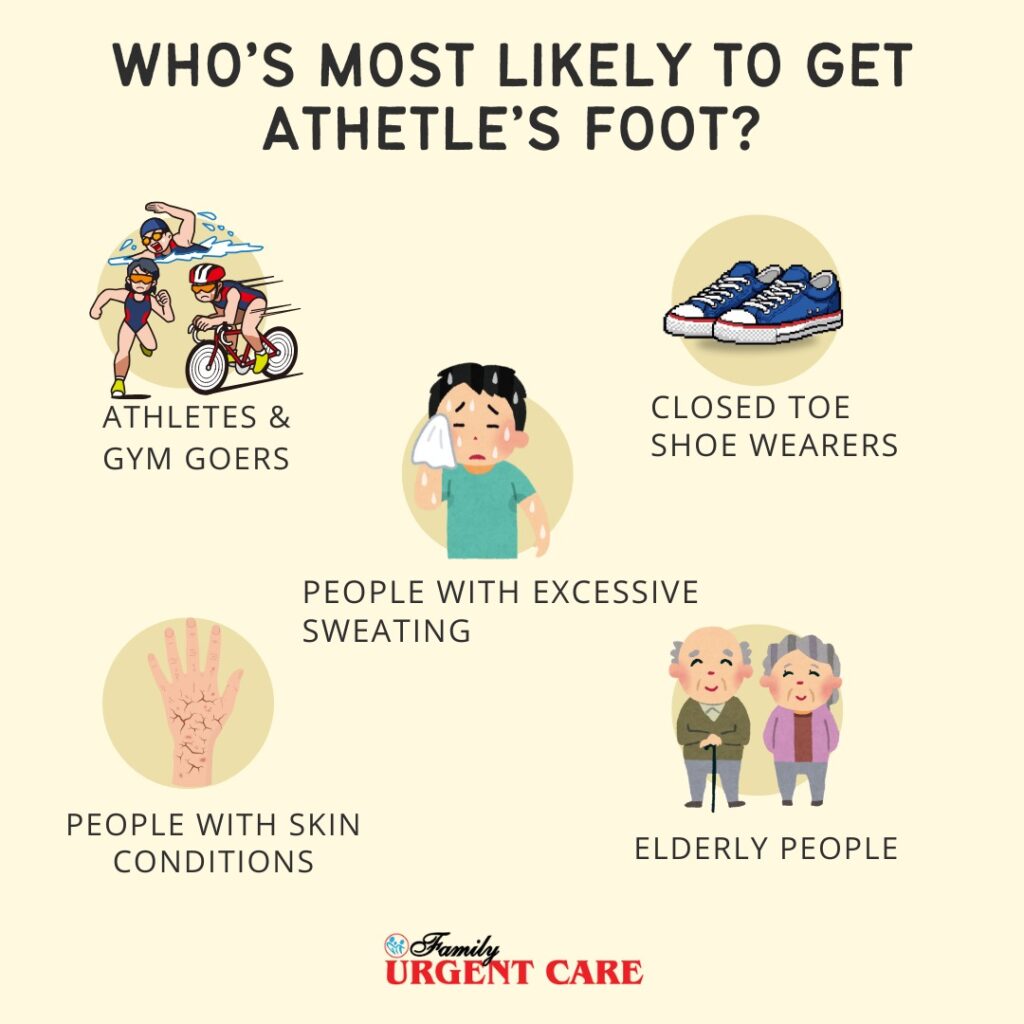Consult An Experienced Healthcare Professional For Athlete’s Foot Treatment
Athlete’s foot, also known as tinea pedis, is a common fungal infection that affects the skin of your feet and the space between the toes. It occurs in people whose feet are exposed to warm, moist or damp environments, such as wearing tight or thick shoes for long hours.
Although the symptoms might be mild and complications are rare, it is essential to seek expert medical care to reduce future complications.
Therefore, as soon as you notice any unusual symptoms on your foot, such as itchiness, rash, or white patchy skin between the toes or foot, you need to contact an urgent care clinic immediately.
Common Symptoms of Athlete’s Foot
If you notice any telltale signs of Athlete’s foot, contact the Family Urgent Care clinic and visit us for early treatment. Some common symptoms include:
- Itchy white patches between the toes
- Scaling, peeling, or cracked skin
- The affected area appears red or brown.
- Itchiness, burning, or stinging, especially when you remove your socks or shoes.
- Dry, scaly skin on the bottom or side of the foot
Can an Athlete’s Foot Spread?
Yes, athlete’s foot can spread to healthy individuals from damp and wet environments, such as public showers or pool areas. It can also occur if you touch an affected foot or use any contaminated belongings from the affected person.
As long as the person has a fungal infection on the feet, it is contagious and spreads from person to person. Therefore, if you have athlete’s foot or are at a higher risk of developing a fungal infection, you need to be cautious and practice healthy foot hygiene by avoiding warm and damp environments. You can also visit an urgent care clinic for proper counseling and care from experienced healthcare providers.
Who Is At More Risk Of Athlete’s Foot?

Some people are more likely to develop athlete’s foot than others. You may be at higher risk if you fall into one of these groups:
Athletes, Swimmers, or Gym-Goers: Wearing tight shoes and socks for long hours or using shared showers and locker rooms creates a warm, moist environment where fungus grows easily.
People Who Wear Closed-Toe Shoes Often: Jobs that require heavy or closed shoes, like construction or military work, can trap sweat and heat, encouraging fungal growth.
Those With Skin Conditions: Conditions like eczema or psoriasis can damage the skin’s barrier, making it easier for fungus to enter and cause infection.
Older Adults: Elderly individuals may have weaker immune systems or difficulty keeping their feet completely dry, which can increase risk.
People Who Sweat Excessively: Those with hyperhidrosis (excessive sweating on the feet, hands, or armpits) are more prone to fungal infections.
If you fit into any of these groups, practice good foot hygiene, keep your feet clean and dry, and change your socks regularly. Be especially careful if you have diabetes or an immune condition like HIV or AIDS.
How You Can Prevent Athlete’s Foot?
Remember that the fungus grows in warm, moist, and closed areas. Therefore, make sure not to give a favorable environment for the fungus to grow. Here are some handy tips to prevent athlete’s foot this summer:
- Avoid wearing tight and thick shoes or socks for long hours.
- Completely dry your feet after exercising, bathing or removing your shoes.
- Wear shower shoes or flip-flops when walking around pools, gyms or locker areas.
- If someone around you has athlete’s foot, make sure not to share any clothes, towels or shoes.
- Take off your shoes at home and let your feet breathe.
When Should You Visit A Nearby Doctor For Athlete’s Foot?
- If you notice any signs of inflammation, such as pain, swelling or pus in your feet and fever.
- If you have an itchy rash that doesn’t improve within two weeks of taking over-the-counter medicines.
- If your symptoms are not improving even after taking antifungal medicines
- You have a recurring fungal infection.
- If you have diabetes and suspect athlete’s foot symptoms, you need to consult a healthcare professional without any delay.
- If you have any immunocompromised condition like HIV or AIDS along with athlete’s foot, contact the doctor right away.
How Can Family Urgent Care Help In Recovering From Athlete’s Foot?
It’s time to say goodbye to the troublesome fungal infection, as our team is here to turn the irritating symptoms into relief by giving you personalized treatment and counseling you on practicing foot hygiene.
Once you visit Family Urgent Care for Athlete’s foot, our healthcare providers examine your feet, ask you about any other unusual symptoms and take a culture test if necessary. The doctor then prescribes appropriate topical or oral antifungal medications, depending on the severity of your infection.
Not to mention, if your symptoms do not improve and you wish to consult a healthcare professional, you can also book a same-day phone or video appointment within minutes and consult our healthcare experts without any hassle of commuting to the clinic.

